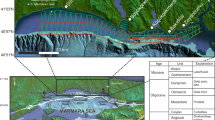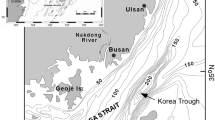Abstract
The sedimentary cover section of the North Kara Shelf had been subdivided based on extensive seismic data, and seismic correlation was carried out. The predominant role of Upper Riphean-Middle Paleozoic rocks has been corroborated. A series of relatively deepwater basins filled with primarily terrigenous fly-schoid rocks up to 7–9 km in thickness existed in the Late Riphean-Vendian at the place of the shelf. In the Cambrian, isolated basins merged into a wide and shallow-water basin as a result of the Baikalian reactivation in southeast Severnaya Zemlya and probably in Taimyr. After the pre-Ordovician hiatus, a vast sedimentation basin with a regressive section was formed on the shelf from Ordovician to Late Devonian. Shallow-water marine and near-shore carbonate and carbonate-terrigenous sequences accumulated in this basin and gave way to continental and less frequent near-shore, marine, variegated, and red beds in the Devonian. The thickness of the Ordovician-Devonian sequence reaches 6 km. Since the Mid-Carboniferous, block emergence and deep erosion of Ordovician-Devonian complexes have occurred in the north Kara shelf as a result of Hercynian events in northern Taimyr, Severnaya Zemlya, and in the southern Kara Sea. No Permian-Triassic rifts existed on the North Kara Shelf. At that time, the shelf was an area of erosion. The thickness of the Middle Carboniferous-Cretaceous sequence was insignificant and gradually increased toward Barents Sea troughs. The newly formed Svyataya Anna and Voronin troughs arose due to opening of the Eurasia Basin of the Arctic Ocean. The terrane concept has been subjected to criticism. The available data show that a large epi-Grenvillian continental block existed, and the North Kara region was part of it. Collision of the northern continent with the Paleosiberian Platform in the Late Paleozoic resulted in the formation of the Hercynian fold arc to the south of the North Kara Shelf, and an inverted orogenic arch arose at the place of shelf basin. The individual geological features that distinguish the North Kara Shelf from the Barents Sea troughs and the South Kara Syneclise are emphasized. The ancient pre-Riphean basement, a system of Late Riphean-Vendian relatively deepwater troughs and basins, Hercynian tectonic inversion, deep erosion of the most uplifted part of the arch, and significant block motions are the distinguishing features of the North Kara Shelf.
Similar content being viewed by others
References
S. V. Aplonov, G. B. Shmelev, and D. K. Krasnov, “Geodynamics of the Barents-Kara shelf: Geophysical evidence,” Geotectonics 30(4), 309–326 (1996).
The Barents Shelf Plate, Ed. by I. S. Gramberg (Nedra, Leningrad, 1988) [in Russian].
V. V. Bezzubtsev, R. Sh. Zalyaleev, A. B. Sakovich, et al., Geological Map of the Mountain Taimyr on a Scale of 1: 500000. Explanatory Notes (Krasnoyarsk PGO, Krasnoyarsk, 1986) [in Russian].
V. V. Verba and M. L. Verba, “Extension structures of the Earth’s crust in Arctic Geodepression,” in Russian Arctica: Geological History, Minerageny, and Geoecology, Ed. by D. A. Dodin and V. S. Surkov (VNIIOkean-geologiya, St. Petersburg, 2002), pp. 93–108 [in Russian].
M. L. Verba and G. I. Ivanov, “Tectonic Map of the Barents-Kara Region on a Scale of 1: 2500000: Petroleum Geological and Geoenvironmental Forecast,” in Proceedings of RAO/CIS Offshore 2009 (Khimizdat, St. Petersburg, 2009) [in Russian].
M. L. Verba, Yu. Matveev, Yu. V. Roslov, and T. S. Sakulina, “Lithosphere of the Kara-Barents shelf plate and Arctic shore of European shelf: Results of investigations along reference profile 2-AR),” in Structure of the Lithosphere in Russian Part of the Barents Region, Ed. by N. V. Sharov, F. P. Mitrofanov, M. L. Verba, and K. Gillen (Karelian Sci. Center, Russian Acad. Sci., Petrozavodsk, 2005), pp. 182–216 [in Russian].
V. A. Vernikovsky, Geodynamic Evolution of the Taimyr Fold Region (UIGGM, Siberian Branch, RAS, Novosibirsk, 1996) [in Russian].
Geology and Mineral Resources of Russia: Arctic Seas, Ed by I. S. Gramberg, V. L. Ivanov, and Yu. E. Pogrebitsky (VSEGEI, St. Petersburg, 2004), Vol. 5, Book 1 [in Russian].
State Geological Map of the Russian Federation on a Scale of 1: 1000000 (New Series). Map Sheets T-45-47 (Oktyabr’skoi Revolyutsii Island) and T-48-50 (Bol’shevik Island). Explanatory Notes (VSEGEI, St. Petersburg, 2003) [in Russian].
L. A. Daragan-Sushchova and A. V. Kopylova, “Empirical relationships of layer velocities to depth of layer subsidence from the data of borehole investigations and marine seismic exploration,” in Geophysical Research of Shelf and Continental Slope (Sevmorgeologiya, Leningrad, 1990), pp. 28–31 [in Russian].
L. A. Daragan-Sushchova, Yu. I. Daragan-Sushchov, D. D. Rukavishnikova, E. O. Petrov, V. V. Solov’ev, and L. F. Kuznetsova, “Phanerozoic evolution of the Barents-Kara region based on analysis of structural and paleostructural maps,” Region. Geol. Metallogen., No. 38, 21–30 (2009).
L. A. Daragan-Sushchova, O. V. Petrov, and Yu. I. Daragan-Sushchov, “Severo-Karskii region as a part of the Barents Sea Megatrough or a self-dependent structural element?” in Proceedings of RAO/CIS Offshore 2011 (Khimizdat, St. Petersburg, 2011), pp. 54–60 [in Russian].
A. I. Zabiyaka, I. D. Zabiyaka, V. A. Vernikovsky, et al., Geology and Tectonic Evolution of Northeastern Taimyr (Nauka, Novosibirsk, 1986) [in Russian].
V. Ya. Kaban’kov, “Stratigraphy and correlation of Late Precambrian sedimentary rocks of the Taimyr-Severnaya Zemlya and Paikhoi-Novaya Zemlya fold regions,” in Topical Problems of Regional Geology of the Barents-Kara Shelf (VNIIOkeangeologiya, St. Petersburg, 1997), pp. 29–30 [in Russian].
V. G. Kuz’min and Yu. D. Shul’ga, “Novaya Zemlya-Severnaya Zemlya structural-tectonic zone and its Phanerozoic evolution,” in Topical Problems of Regional Geology of the Barents-Kara Shelf (VNII-Okeangeologiya, St. Petersburg, 1997), pp. 38–39 [in Russian].
N. A. Malyshev, V. A. Nikishin, A. M. Nikishin, V. V. Obmetko, V. N. Martirosyan, L. N. Kleshchina, and Yu. V. Reidik, “A new model of the geological structure and evolution of the North Kara sedimentary basin,” Dokl. Earth Sci. 445(1) 791–795 (2012).
V. A. Markovsky and A. A. Makar’ev, “Ordovician rocks of Severnaya Zemlya,” in Geology of Severnaya Zemlya Archipelago (Sevmorgeologiya, Leningrad, 1982), pp. 22–39 [in Russian].
E. E. Musatov, “Neotectonics of Arctic continental margins,” Izv. Physics Solid Earth 32(12), 986–991 (1996).
Explanatory Notes to the Tectonic Map of the Kara and Laptev Seas and Northern Siberia on a Scale of 1: 2500000, Ed. by N. A. Bogdanov and V. E. Khain (ILRAN, Moscow, 1998) [in Russian].
O. V. Petrov, L. A. Daragan-Sushchova, N. N. Sobolev, and Yu. I. Daragan-Sushchov, “Structure of pre-Jurassic basement of the northern West Siberian Plate,” Region. Geol. Metallogen., No. 26, 153–168 (2005).
Yu. E. Pogrebitsky, Paleotectonic Analysis of the Taimyr Fold Region (Nedra, Leningrad, 1971) [in Russian].
S. G. Samygin, “Vendian nappes and tectonic evolution of Taimyr in Late Precambrian,” Byull. MOIP, Otd. Geol. 87(4), 3–19 (2012).
Severnaya Zemlya. Geology and Minerageny, Ed. by I. S. Gramberg and V. I. Ushakov (VNIIOkean-geologiya, St. Petersburg, 2000) [in Russian].
V. S. Surkov, O. G. Zhero, and L. V. Smirnov, “Arctic-North Atlantic rift megasystem,” Geol. Geofiz. 25(8), 3–11 (1984).
E. V. Shipilov and G. A. Matishov, “Tectonic setting and geodynamic nature of the Saint Anna Trough (Northern Barents-Kara continental margin),” Dokl. Earth Sci. 411a(9), 1370–1374 (2006).
H. Lorenz, P. Mannik, D. Gee, and V. Proskurnin, “Geology of the Severnaya Zemlya Archipelago and the North Kara Terrane in the Russian high Arctic,” Inter. J. Earth Sci. 97, 519–547 (2008).
D. V. Metelkin, V. Vernikovsky, A. Yu. Kazansky, et al., “Paleozoic history of the Kara microcontinent and its relation to Siberia and Baltica: Paleomagnetism, paleogeography and tectonics,” Tectonophysics 398, 225–243 (2005).
Author information
Authors and Affiliations
Corresponding author
Additional information
Original Russian Text © L.A. Daragan-Sushchova, O.V. Petrov, Yu.I. Daragan-Sushchov, M.A. Vasil’ev, 2014, published in Geotektonika, 2014, Vol. 48, No. 2, pp. 61–74.
Rights and permissions
About this article
Cite this article
Daragan-Sushchova, L.A., Petrov, O.V., Daragan-Sushchov, Y.I. et al. Structure of the North Kara Shelf from results of seismostratigraphic analysis. Geotecton. 48, 139–150 (2014). https://doi.org/10.1134/S0016852114020022
Received:
Published:
Issue Date:
DOI: https://doi.org/10.1134/S0016852114020022




